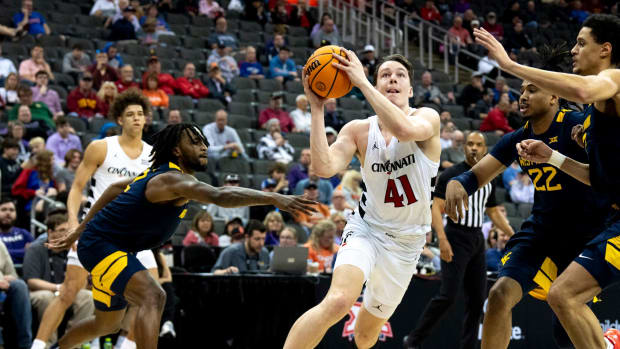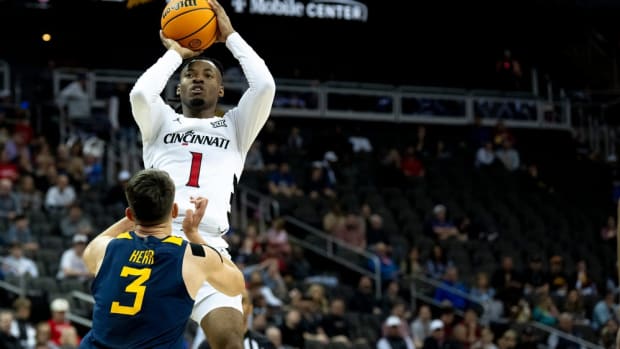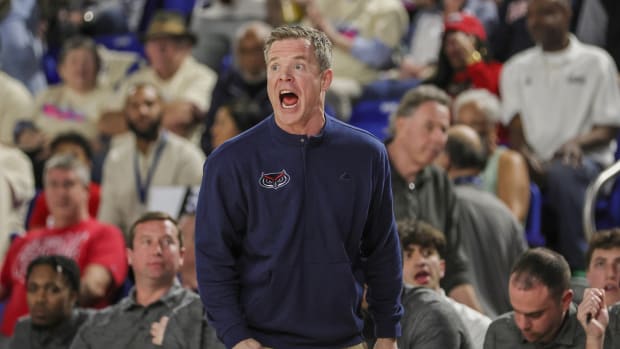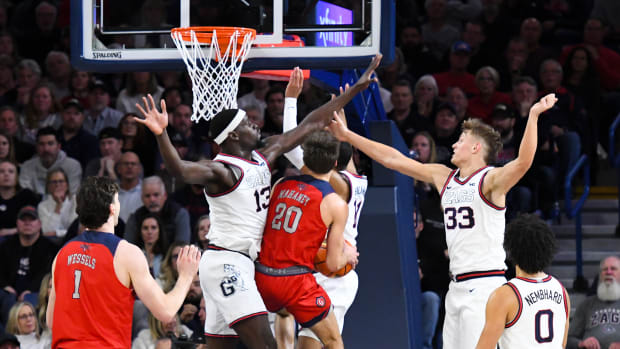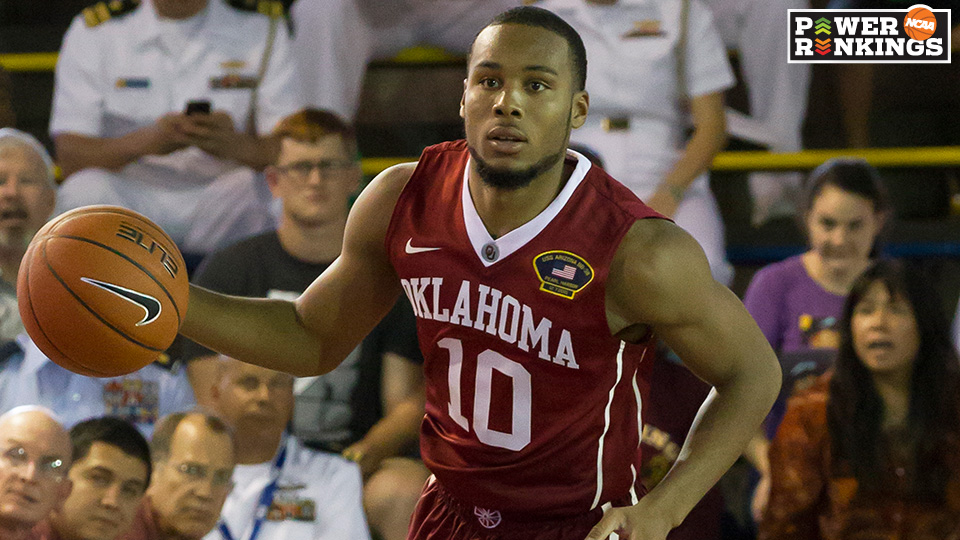
Power Rankings: Michigan State still No. 1 as Oklahoma moves into top 5
Volume III of the Power Rankings digs into Sparty's wild shooting data, Duke's best lineups, The Huggy Dance, The Larra-Nae-Nae, and the songs of 2015:
1. Michigan State Spartans
PREVIOUS: 1
RECORD: 10-0
A wild and probably unsustainable driver of the Spartans’ success in 2015–16 has been their incredible efficiency on off-the-dribble jumpers—shots that aren’t typically efficient unless your name is Stephen Curry.For some context: In 2014–15, the nation’s teams combined to score 0.78 points per possession on off-the-dribble jumpers, compared to 1.02 PPP on catch-and-shoot jumpers, according to Synergy Sports Technology’s logs. As the scatterplot below shows, only four of 351 teams were more efficient shooting off the dribble than they were off the catch in ’14–15; none of those four (Cleveland State, Missouri State, North Texas and Sacred Heart) made the NCAA tournament. Michigan State was 0.34 PPP worse shooting off the dribble than it was off the catch last season.Which brings us to this season, where the Spartans, through Wednesday, were leading the nation in off-the-dribble shooting efficiency, at 1.37 PPP on 49 attempts. They’ve been crazy good at a thing that drags down most offenses. Denzel Valentine is averaging 1.20 PPP shooting off the dribble (on 25 shots), Eron Harris is averaging 1.71 PPP (on seven shots), and Bryn Forbes is averaging 2.00 PPP (on six shots). These are tiny samples, and are highly unlikely to hold up, but they've made Michigan State a rare team for whom catch-and-shoots aren’t its best option. Here’s a plot of how every team with at least seven games logged in ’15–16 falls on the dribble-vs.-catch grid, with Sparty as the extreme, yellow data point:Next up: 12/12 vs. Florida, 12/19 at Northeastern
2. North Carolina Tar Heels
PREVIOUS: 2
RECORD: 7-1
Adrian Atkinson, whom the Power Rankings considers to be the authority on North Carolina lineup efficiencies, Tweeted an eye-opening Theo Pinson nugget this week: “Through 8 games, UNC is 33.2 points / 100 possessions better with Pinson on the court—26 better on offense, 7 better on defense.” Atkinson added that the Tar Heel with the next-highest efficiency margin is point guard Joel Berry, at +14.8 points per 100 possessions.This is notable not because it serves as conclusive evidence that Pinson, a 6'6" sophomore guard, is North Carolina's most valuable player—it’s only eight games of data!—but because Pinson is one of the players whose minutes have been cut most by the return of Marcus Paige. While UNC’s star senior guard was injured, Pinson averaged 28.5 minutes per game; now that Paige is back, Pinson is averaging 17.5. The Heels have seemed fine in that arrangement, beating Maryland and routing Davidson, but this is something to monitor, whether Carolina needs Pinson’s playmaking to reach its peak level of offense.Next up: 12/12 at Texas, 12/16 vs. Tulane
3. Kansas Jayhawks
PREVIOUS: 3
RECORD: <a href="/college-basketball/team/kansas-jayhawks">Kansas</a>
Michigan State is shooting out of its mind on off-dribble jumpers ... and Kansas junior guard Wayne Selden is shooting out of his mind on pretty much everything, averaging 1.64 PPP on his 44 jumpers prior to Wednesday’s game against Holy Cross, according to Synergy. Selden was under 1.0 PPP on his jumpers last season, and a big key to his surge has been cutting out short- and medium-range attempts, which accounted for 32.1% of his attempts as a sophomore. This season that figure has dropped to 13.2%. Kansas coach Bill Self has adjusted how he’s using Selden in the offense—playing him at the 3 alongside dual point guards Frank Mason and Devonte’ Graham, cutting down on Selden’s ball-handling and playmaking responsibilities, freeing him up to focus on shooting—and it’s led to him shooting 58.3% from long range.Kansas has even adjusted some its end-game actions to showcase Selden, such as the following play that set up a 2-for-1 opportunity at the conclusion of the first half of its Dec. 1 win over Loyola (Md.). Rather than have Perry Ellis set a high ballscreen for Mason, Ellis hangs back, waits for Mason’s isolation penetration to draw in Selden's wing defender—and then backscreens Selden’s man to free up a kick-out three.Next up: 12/12 vs. Oregon State, 12/19 vs. Montana
4. Oklahoma Sooners
PREVIOUS: 8
RECORD: 6-0
While I’m on the topic of guards transitioning to more optimal, off-ball roles, and breaking out as shooters, Oklahoma junior Jordan Woodard is another prime example. Woodard still plays a number of possessions at the point, and will lead the Sooners’ fastbreak if he’s the guard closest to whoever grabs a defensive board, but senior Isaiah Cousins has been initiating the offense a majority of the time. Cousins’s penetration creates clean looks for Woodard on the wing, and he’s shooting 52.0% from deep after being a 25.4% long-range guy last season—and his turnover volume is way down in this increased catch-and-shoot role. Here’s just one example of the Cousins (No. 11)-Woodard (No. 10) dynamic, from Oklahoma's 78–55 rout of Villanova in Hawaii on Monday:Next up: 12/12 vs. Oral Roberts, 12/19 vs. Creighton
5. Maryland Terrapins
PREVIOUS: 4
RECORD: 8-1
Freshman center Diamond Stone had his big-stage breakout in Tuesday’s win over UConn in the Jimmy V Classic, scoring 16 points and grabbing nine rebounds in 22 minutes. Maryland coach Mark Turgeon removed Stone from the starting lineup following a Dec. 1 loss to North Carolina, and the 6'11" prospect has responded well, averaging 16 points and 6.5 boards in a reserve role since.The question of how Maryland can best deploy Stone remains an interesting one. He’s a five-star freshman, obviously talented, and might be a first-round pick in 2016 ... but when he’s on the floor, he becomes the focal point of the Terps’ offense, taking 33.5% of their shots—and he’s hardly their most efficient scoring option, nor does he facilitate ball movement, having dished out just two assists in 158 minutes played. Maryland’s best frontcourt combo this season has been the one that's now starting: Robert Carter and Damonte Dodd. The Terps have an efficiency margin of +37 points per 100 possessions in Carter/Dodd lineups, compared to +15 in Carter/Stone lineups, according to data from HoopLens.com.Next up: 12/12 vs. Maryland Eastern Shore, 12/19 vs. Princeton (in Baltimore)
6. Kentucky Wildcats
PREVIOUS: 5
RECORD: 8-1
Why it’s a good year for Kentucky to have guards that rebound, particularly freshman Isaiah Briscoe, whose defensive-board percentage (17.3%) is the second-highest on the team ...The numbers above, from Sports-Reference.com, show that Skal Labissiere is the lightest-rebounding freshman big in the John Calipari Era other than Kyle Wiltjer. Wiltjer, four years later, has become a decent defensive-boarder at Gonzaga, but Calipari needs Labissiere to increase his production in a much shorter timeframe. (If that doesn't happen, maybe the answer is New Zealander Tai Wynyard.)Next up: 12/12 vs. Arizona State, 12/19 vs. Ohio State (in Brooklyn)
7. Duke Blue Devils
PREVIOUS: 6
RECORD: 8-1
Responding to a Twitter call for Power Rankings investigation topics, reader @DukeForum proposed looking into “whether Duke is more efficient with two big men on the floor or just one.” This being a good idea and worthy topic, I looked into it using HoopLens.com’s lineup data. The Blue Devils have been slightly better when they use two bigs, due to a noticeable defensive split—0.92 PPP allowed by the big lineups, 1.03 PPP allowed by the small-ball lineups:* To clean up the data, I threw out the 25 garbage-time possessions Duke had with big-big combos of Sean Obi-Chase Jeter and Chase Jeter-Antonio Vrankovic, as those will never, ever happen in meaningful games. The three big-big combos analyzed were Amile Jefferson-Marshall Plumlee (the most common, by far, with 273 offensive possessions), Jefferson-Jeter and Plumlee-Jeter.Next up: 12/15 vs. Georgia Southern, 12/19 vs. Utah (in New York)
8. Iowa State Cyclones
PREVIOUS: 9
RECORD: 7-0
The best thing about Thursday’s Cy-Hawk rivalry will be getting to evaluate Iowa State against a real offense. Senior Georges Niang recently credited new coach Steve Prohm for the Cyclones’ defensive gains—they rank 16th in adjusted efficiency, after being outside the top 70 for Fred Hoiberg’s final three seasons—but they've also yet to face even a top-60 offense. Iowa ranks 20th in offensive efficiency, can score inside and out, likes to run, and should be a decent measuring stick for Iowa State’s ability to guard. The Cyclones’ most important defender is the hyper-active Jameel McKay, who has as many blocks (11) as he does fouls, and leads their strong defensive-rebounding efforts. The more defensive boards Iowa State can grab, the more it can get into its lethal transition scoring attack, which Buffalo coach Nate Oats described (to the Ames Tribune) as “like five sprinters running a 100-meter dash.”Next up: 12/10 vs. Iowa, 12/13 vs. Arkansas Pine Bluff
9. Virginia Cavaliers
PREVIOUS: 10
RECORD: 8-1
I wrote everything I could possibly write about the Cavaliers after covering Tuesday’s win over West Virginia at the Jimmy V Classic, so this space will be devoted to gif-ing one of the finer coaching moments of this young season: Bob Huggins’s rage-dance response to Jevon Carter passing up a transition layup in favor of an around-the-back pass turnover against the Cavaliers. I put it in slow motion; focus on Huggy in the top right corner, and how he breaks into his arm-pumping dance and pulls a sub off the bench before Virginia even gets the ball past halfcourt.This happened seven minutes into the second half. Huggins benched Carter for the remainder of the game. “I don’t have any idea what he was thinking,” the coach said of Carter afterwards. “He had a layup. I don’t know what he was thinking.”Next up: 12/19 vs. Villanova, 12/22 vs. Cal
10. Purdue Boilermakers
PREVIOUS: 11
RECORD: 10-0
The Boilermakers opened the season with Johnny Hill, a graduate transfer from UT-Arlington, as their starting point guard. After Hill struggled against Florida on Nov. 22, a game in which his sophomore backup, P.J. Thompson, scored 15 points and dished out four assists against zero turnovers, Thompson took over the starting job. Thompson has been an efficient, sure-handed point guard this year, with an assist-to-turnover ratio of 28 to 5, but it’s possible that Purdue will be better in Big Ten play with Hill on the floor. In the Boilers’ four games against top-100 opponents—Old Dominion, Pitt, New Mexico and Florida—they have an efficiency margin of +35 points per 100 possessions with Hill at the point, and +19 with Thompson at the point. Hill is a non-shooter, which leads to some spacing issues, but Purdue’s defense seems to be at its stingiest with him in the game.Next up: 12/12 vs. Youngstown State, 12/19 vs. Butler (in Indianapolis)
11. Miami (FL) Hurricanes
PREVIOUS: 14
RECORD: 8-1
Florida coach Mike White, to the Miami Herald, after losing 66–55 to the Hurricanes on Tuesday:“I just don’t know what [the 'Canes’] glaring weakness is. They’ve got length. I was impressed with their girth. There’s some big guys. Really impressed with their physicality, defensively. They play hard. They can spread you. [Their] backcourt [is] really good. [Center Tonye] Jekiri I was impressed with his ability to alter and block shots. They can make threes. They’re good at a lot of things.”Fair assessment. But I was less impressed with Miami’s girth than I was with coach Jim Larrañaga’s Whip/Nae Nae:Next up: 12/19 vs. Charleston, 12/22 at La Salle
12. Villanova Wildcats
PREVIOUS: 7
RECORD: 7-1
You lose by 23 on a neutral court when you’re a kenpom No. 1, you lose your blurb to something irrelevant: the Power Rankings’ Songs of the Year Rankings, a long-running tradition that never fails to annoy fans of whichever team's space it occupies, while potentially pleasing the tiny fraction of readers who overlap on the college hoops/music Venn diagram:1. “I Know There's Gonna Be (Good Times),” Jamie XX (feat. Young Thug & Popcaan)2. “Ordinary People (Live 1988, from Bluenote Cafe),” Neil Young3. “River,” Leon Bridges4. “How Could You Babe,” Tobias Jesso Jr.5. “Loud Places,” Jamie XX (feat. Romy)6. “CHA CHA,” D.R.A.M.7. “You Got Under My Skin” (and “Nostalgia Blues”), Simon Joyner8. “1922” (and “Ain't It Sweet”), Phil CookFor a Songs of 2015 list by someone more reputable on the subject, I suggest you visit my friends at Gorilla vs. Bear.Next up: 12/13 vs. La Salle, 12/19 at Virginia
13. Xavier Musketeers
PREVIOUS: 19
RECORD: 9-0
Musketeers senior James Farr is the ultimate example of a Rebound Reliever: a guy who comes off the bench and absolutely owns the glass. He had 10 boards in 14 minutes during their rout of Wright State on Tuesday, and through Tuesday’s games, ranked fourth nationally in rebounds per 40 minutes (pace-adjusted), according to DraftExpress.com‘s data.Next up: 12/12 vs. Cincinnati, 12/19 vs. Auburn
14. Providence Friars
PREVIOUS: 16
RECORD: 9-1
Really hoping that Friars sophomore Ben Bentil didn’t suffer a serious injury against Boston College on Wednesday night. He rolled his ankle early in the second half, had to leave the game for good, and is getting an X-ray Thursday in Providence. (There’s also an unconfirmed Tweet of someone seeing Bentil in a walking boot and on crutches Thursday.) He’s been the most unexpected star of this season, morphing from an average role-player as a freshman to an all-conference-level forward as a sophomore. He’s averaged 21.2 points against the Friars’ five top-100 opponents, and if Providence is going to challenge Villanova for the Big East title, Bentil has to be healthy.Next up: 12/12 vs. Bryant, 12/19 vs. Rider
15. Arizona Wildcats
PREVIOUS: 17
RECORD: 8-1
Coach Sean Miller has been tinkering with his lineups this season, both before and after center Kaleb Tarczewski went down with an injury, and although the Wildcats are nowhere near their ceiling as a team, they have found a combo that clicks: giving senior Gabe York and freshman Allonzo Trier heavy minutes together at the 2-3 spots. It’s obvious that Arizona’s offense is at its peak with those two on the floor—especially with Trier hitting his stride in December, scoring 27 points in Wednesday’s win over Fresno State—and the drop-off in effectiveness from the York-Trier combo to York-Elliott Pitts at the 2-3 is significant.Next up: 12/13 vs. Missouri, 12/16 vs. Northern Arizona
16. Baylor Bears
RECORD: 7-1
Ken Pomeroy pointed out earlier this week that Rico Gathers’s personal offensive-rebounding percentage of 22.1 is better than 30 Division-I teams. One of those teams is Northwestern State, which faced Baylor on Tuesday, and Gathers vs. NSU’s front line wasn’t fair. The 275-pound monster had 12 offensive rebounds (and 21 total boards) in 33 minutes.Baylor’s play-by-play data listed two possessions in which Gathers had three O-Rebs in a matter of seconds. In the case below, two of them were volleyball with his own misses:And in the second case, it seems that Baylor credited Gathers with an extra offensive board. The dude already dominates. He doesn’t need stat-padding:Next up: 12/16 vs. Hardin Simmons, 12/19 at Texas A&M
The next 16
17. Louisville
18. Butler
19. SMU
20. West Virginia
21. Cincinnati
22. Utah
23. George Washington
24. Dayton
25. Texas A&M
26. Gonzaga
27. Oregon
28. Vanderbilt
29. Georgetown
30. South Carolina
31. Richmond
32. Wake Forest
















